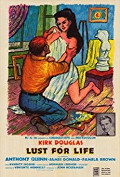
Directed by
Vincente Minnelli
122 minutes
Rated PG
Reviewed by
Bernard Hemingway

Lust For Life
Vincent van Gogh's story exemplfies the paradigmatic tortured artist and Vincente Minnelli’s film, and Kirk Douglas’s central performance in particular, plays that card to the hilt. For all that, and especially for big studio Hollywood of the time and as much as it is in thrall to the legend, in the hands of producer John Houseman Lust for Life is a commendably conscientious effort to use van Gogh’s painting as the record of and mirror to his life.
Based on popular writer Irving Stone’s novel and scripted by Norman Corwin, the core of the story is van Gogh’s unstable, obsessive personality which manifested itself in emotional, intellectual and spiritual anxiety as he struggles to exorcise his demons (there is no doubt that he was clinically mentally unwell but no there is no agreement as to what his ailment was), charting his life from his time as a pastor to impoverished coal miners in Belgium in the late 1870s to his eventual suicide in 1890. The two aspects, the man and his art, are seamlessly merged with the film reproducing many of van Gogh’s now familiar paintings as settings for the narrative so that we get a convincing sense of his experiences and how they were transposed to canvas. To bring this off the film was shot in widescreen Cinemascope and vibrant Ansco Color (which was labeled in the credits as Metrocolor), an example of the trouble taken to match reality and representation being the very Kurosawa-like move on the part of director Vincente Minnelli of having a portion of a field spray-painted yellow to closer resemble van Gogh's painting).
As van Gogh, in a role originally intend for Spencer Tracy, Douglas who manages to look convincingly like the artist as memorialized in own self-portraits, gives a strongly empathetic performance, playing the never less than intense, at times pathetic, at times quite mad, artist yet only at times falling into the histrionic. Anthony Quinn who won a Best Supporting Actor Oscar is also effective as Gaugin, the artist who both inspired and, apparently, bullied Van Gogh (Douglas was nominated as Best Actor but the Oscar went to Yul Brynner for The King and I).
Although when depicting the personal aspects of van Gogh’s life, the film is very ordinary in a stock-standard 1950s way and these scenes could have been omitted from what is an over-long film, Lust For Life still holds up thanks to the dedication to the artist and his work. .
FYI: George Cukor directed some scenes but was uncredited.
Want something different?





